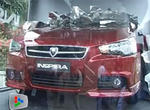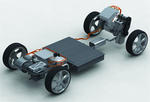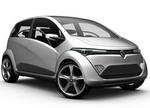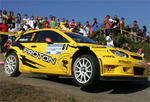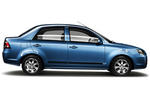
The new 2008 Proton Persona was launched today on the Australian market. The 2008 Proton Persona shares only its name with the previous version, the 2008 model being based on the GEN.2 platform. The 2008 Proton Persona is powered by an improved version of the Campro 1.6 liter twin cam engine that develops 82 kW at 6000 rpm and 148 Nm of torque at 4000 rpm. The top speed of the 2008 Proton Persona is 190km/h (185 km/h automatic) while the 0 to 100 km/h acceleration time is 12 seconds. The 2008 Proton Persona has a fuel consumption of 6.6 liters per 100kms combined average for the manual (6.7L/100km for auto).
The 2008 Proton Persona price starts at $16,990 for the five speed manual version and $18,990 for the automatic.
Proton Press Release:
Persona Brings A Fresh New Face And Improved Quality For Proton In Australia
Proton Cars has launched an all-new Persona onto the Australian market with fresh styling, improved build quality and better performance.


The new Persona shares only its name with the previous Proton Persona model, a car that was sold in Australia between 1995 and 2005. The new model however is based on the Proton designed and developed GEN.2 platform and uses an improved version of Proton's own Campro 1.6 liter twin cam engine.
The new Persona will come to market with a recommended retail price of $16,990 plus on roads for the five speed manual and $18,990 for the four speed automatic. It will be available in one fully equipped trim level, underlining the car's tremendous value.
An expansive standard equipment list includes ABS antilock brakes with EBD, driver and front passenger SRS airbags, climate control air conditioning, power windows, remote keyless entry and boot release, electric remote control mirrors, electronic reversing sensors, AM/FM/MP3/CD audio system and alloy wheels.
The interior is a refinement of the current GEN.2 design with its sporty Lotus inspired instrument binnacle and air conditioning controls while incorporating a new black and grey dash trim,
an integrated glove box, new door mounted power window and remote mirror controls as well as improved seats and a redesigned center console.
The Persona has been a runaway success in its native Malaysia, where it has helped return Proton to profit and boosted market share for the company. The Malaysian domestic sales success has come on the back of dramatic improvements in build quality, driveability and interior design.
According to Proton Cars Australia managing director, John Startari, the new Persona delivers on the basics offering buyers a better overall package while maintaining Proton's reputation for excellent fuel economy, high equipment levels and value for money.
"The first thing Persona drivers will notice is the integrity and quality improvements as well as the lift in performance thanks to better engine management programming," said John Startari.
"Add these improvements to the already pleasing styling and the remarkable ride and handling package engineered by Lotus and the Persona is clearly the most complete and pleasing car the company has produced so far," he added.
While Persona shares its DNA and many styling cues with its sibling the GEN.2, Proton stylists have refined the design delivering a refined, simple but elegant sedan which projects its own individuality.
"Persona certainly answers the potential the Proton marque has been promising since starting its own design and development program almost a decade ago," said John Startari.
Style, safety, spaciousness, practicality, quality, comfort and performance are the seven key areas that guided Proton designers in formulating a package to meet the requirements and expectations of a wide spectrum of buyers.
Persona is strategically positioned as an entry-level four-door sedan, designed and priced for universal appeal to the first time car buyer, replacement car buyer, or families purchasing a second car.
"The new Persona is the manifestation of the new attitude, new processes and the new approach embraced by the company and its personnel," Startari added.
Persona produces maximum power of 82kW at 6000rpm and 148Nm of torque at 4000rpm, however more importantly it delivers fuel economy of just 4.5ltr/100km on the highway cycle for the manual transmission car, the equivalent of 62 miles per gallon in the old money.
Safety has been a high priority for Proton designers both in active and passive terms with a number of refinements to make the car more user friendly.
Active safety is projected via improved steering and handling capabilities, making the new Persona more responsive, predictable and stable, allowing more precision to the driver.
The engineering of the Persona was undertaken in tandem with subsidiary Lotus, a move that maximised the car's safety through a more secure cabin and better structural rigidity.
Persona boasts a spacious 430-litre boot compartment with 60/40 split fold rear seats meaning plenty of luggage space.
Marketing - New Persona Will Definitely Make An Impression
The new Proton Persona is expected to widen the appeal of the Proton marque in Australia by delivering a package that satisfies a broad cross section of motoring demands with strong economy, value for money and performance.
The car will be marketed using the slogan, "Persona - make an impression", a phrase that stresses the Persona's many qualities and standard features.
Proton Cars Australia will emphasise the new Persona's fuel economy credentials, its interior space, Lotus ride and handling and stylish appearance as well as its value for money in its marketing of the new sedan.
Fuel economy will be a key element in the marketing strategy for new Persona according to Proton Cars Australia managing director John Startari.
"Clearly there is a lot of fuel price pressure on motorists at the moment and the Persona is the right car at the right time," said John Startari.
"Many of our dealers are in rural and regional markets as well as on the fringes of major cities where the price of fuel is really biting hard, which means the Persona's frugal fuel use and low purchase price will make it an appealing proposition to these buyers," he said.
"However fuel economy is just one part of the picture, the Persona is a stylish sedan which has benefited greatly from the company's push to improve quality and performance," he added.
"Our research has shown that the Persona has great appeal to a range of buyers and we are encouraged by the reaction to the car by a wide cross section of potential buyers," said John Startari.
"Persona has great interior space including a cavernous boot for a car of this size and this certainly hit a chord with potential buyers.
"It has a presence on the road that will draw attention and we believe will help win more buyers to the Proton marque as our range continues to expand over the next few years," he said.
Persona has spearheaded the company's revitalisation in Malaysia turning around a series of losses to return profit in the first three quarters of the current financial year.
The launch of the all-new Persona in Australia comes at the start of a major expansion in Proton's manufacturing program which will see an increase in production for both export markets and domestic consumption in Malaysia.
By 2011 Proton will almost quadruple export sales from around 14,000 units in 2007 to around 55,000 while production at the company's Tajung Malim facility near Kuala Lumpur will double this year to satisfy increased domestic demand and waiting lists.
Proton is set to launch at least three more new cars in the next year, including new powertrains that will have wider appeal to buyers in export markets such as Australia, where larger engines with high power and torque outputs are demanded by buyers.
The company has already flagged its program to include more performance oriented engines as well as diesel powerplants in its forthcoming cars.
Green Credentials - Persona Is The Greenest Proton Ever
The green credentials of the new Proton Persona have been given official endorsement with the Federal Government Green Vehicle Guide awarding it a four star rating, the first Proton to achieve this level of energy efficiency.
The four star rating is based on both the fuel efficiency and the low level of emissions the new Persona achieves from its 1.6litre Campro twin cam 16 valve engine.
Persona ranks an equal rating with several other smaller cars including Mitsubishi Colt, Smart Four 4, Mini Cooper and Citroen C2, with the same four star rating and beating many far more popular models thanks to its low fuel usage.
The only cars in front of Persona on the Green Vehicle Guide are considerably more expensive and most are smaller than the new Proton.
Persona scores a 6.5 air pollution rating and a 7.5 greenhouse rating in the Green Vehicle Guide, the same as the smaller and more expensive Citroen C2 mini car.
According to Proton Cars Australia managing director, John Startari, the achievement underlines Proton's commitment to building economical and cost effective cars that are also kind to the environment.
"Persona is the first Proton to score a four star rating, however our cars have always returned excellent fuel economy and have been highly rated in the Green Vehicle Guide over the past few years," said John Startari.
"The Jumbuck ute was listed as the greenest and most economical ute or light truck on the Australian market, recording a 3.5 star rating on the 2007 Green Vehicle Guide," he said.
"Proton engineers have done a lot of work refining the engine mapping of the Persona to deliver better fuel efficiency as well as better driveability and performance on the road and that is apparent when you get behind the wheel," he added.
"As well as improvements under the bonnet the Persona has benefited from a cleaner, more aerodynamic design which has lowered drag further enhancing its fuel efficiency as well as lowering noise levels," said John Startari.
The Greenhouse Rating awards a score out of ten for the amount of carbon dioxide (CO2) the vehicle produces, the higher the score the lower the CO2. emitted.
All new vehicle models up to 3.5 tonnes sold in Australia are tested by the government to determine both the fuel consumption and the level of CO2 emissions.
The Air Pollution Rating is based on the level of air pollutant emissions allowable under the standard to which the particular vehicle has been successfully tested for supply to the Australian market.
Powertrain - Proton Puts More Zing Into Campro For Persona
Proton Persona is powered by a 1.6 liter twin cam multivalve version of Proton's own CamPro engine which has been revised and developed to produce better performance and a flatter more even torque delivery while ensuring strong fuel economy and low emission output.
Responsiveness has been improved as a result of a revised Step4 engine management program as well as better tuning and balancing of the total package.
Developed in collaboration with Lotus the CamPro is a strong, reliable, modern, fuel efficient engine and complies with stringent Euro 4 emission requirements
The free revving 1.6 liter, multi-point fuel injected four-cylinder CamPro engine produces 82kW of power at 6000rpm and 148Nm of torque at 4000rpm.
The lightweight all-alloy CamPro1.6 engine has a 76mm bore and an 88mm stroke with a compression ratio of 10:1.
The CamPro1.6 liter engine gives Persona a 0-100kmh acceleration time of 12.0 seconds (14.3 seconds automatic) and a top speed of 190km/h (185 km/h automatic).
The combination of Persona's revised CamPro1.6 liter engine and a low overall kerb weight (1250kg man & 1275kg auto) allows it to achieve excellent fuel consumption of just 6.6 liters per 100kms combined average for the manual (6.7L/100km for auto).
During the development of the CamPro Proton engineers subjected the engine to more than one million kilometres of testing and development before it entered mass production.
Testing was conducted on engine rigs and dynamometers as well as on the road with running prototypes accumulating more than 27,000 hours of running.
A HVAC cooling test was also performed on the CamPro in Japan as Proton and Lotus engineers set out to create a bullet-proof engine designed for performance, reliability, durability and fuss free, affordable maintenance.
Lotus played a key role in CamPro helping achieve a more linear torque progression for better acceleration and driveability.
The CamPro engine in Proton's new Persona is controlled by the latest generation engine management system, the EMS 700 designed and built in Malaysia by Proton.
The EMS 700 interfaces with an on-board digital information display capable of presenting a range of information to the driver.
The multi-function trip computer with odometer and tripmeter can calculate average fuel consumption, journey time, distance to empty and distance in kilometres or miles to the next re-fuelling requirement.
Persona has 12month / 15,000km service intervals.
The new car is equipped with either a five-speed manual transmission or an optional four-speed electronically controlled automatic transmission.
The manual (FSM41) five speed transmission features an overdrive fifth gear along with nicely spaced ratios to give smooth seamless performance across the rev range with a final drive ratio of 4.052.
The electronically controlled four-speed automatic (F4A21) has been re- calibrated to give smoother shifts and a more even power delivery with a direct drive on third and an overdrive on fourth and a final drive ratio of 4.052.
Safety - SAFETY and security a high priority in new proton persona
Safety has played a key role in the engineering and design of the new Proton Persona, from the passive safety intrinsic in the strength and rigidity of the body structure to the active safety elements designed into the car.
Persona has also been designed to provide optimum and uncompromising active safety.
A suite of passive safety devices including dual front SRS airbags, seat belt pre-tensioners, crumple zones and a three part collapsible steering column, protect occupants in case the car is involved in a crash.
From the precise and progressive steering response to its predictable behaviour and enhanced stability the Persona has been engineered to stay out of dangerous situations.
Active safety features include ABS anti lock four wheel disc brakes calibrated for Australian driving conditions, Electronic Brake Force Distribution (EBD), Lotus-tuned ride and handling and power assisted rack and pinion steering as standard.
At the core of the Persona's safety credentials is the strong capsule structure designed to be stiff and secure in critical areas, while absorbing impact in specially designed crumple zones, ensuring occupants are well protected.
Ride and handling and structural integrity work together to make more responsive, safer, stronger cars that ensure better occupant protection and maximum levels of control across a wide array of driving conditions.
With better ride and handling the Persona delivers safer, more stable accurate control at all times. The increased body rigidity and strategic crumple zone placement ensure a safer cabin for optimal passenger protection.
Proton's strong focus on safety also extends to rigorous testing of passenger restraint devices to ensure safety and protection, cushioning occupants and reducing injury from secondary impact.
The three point collapsible steering column absorbs crash impact reducing injury to the driver in a crash while the seat and seat belt anchorage points have been extensively sled tested during the design and development of the Persona.
Seat belts are equipped with seat belt pre tensioners to hold the seat belt firm in a crash while the SRS air bags have been tested and tuned for optimum firing times.
Persona was subjected to, and excelled in, a range of collision and impact tests meeting international safety standards stipulated by Australian and International Design Rules.
It has also been engineered with bake hardened steel as the material for outer panels of both the front and rear doors, giving higher resistance to denting and greater strength to the door structure of the vehicle.
Persona also features an auto lock system which locks all doors when the ignition key is turned on, the brake pedal pressed and the handbrake is released, a safety feature that offers added security particularly for children travelling in the car. The system unlocks in case of an accident situation and when the vehicle is turned off.
Persona features a handy reminder to help prevent drivers leaving headlights on while there is another alarm to help prevent you getting locked out of the car by warning when the key has been left in the ignition.
Design - Simple Yet Elegant Lines Mark New Proton Persona
Proton has rightfully earned a reputation for stylish and adventurous designs since it started developing and building its own cars and platforms over the past eight years.
The new Proton Persona is no exception, inheriting the sporty DNA of its older sibling, the GEN.2 hatch, which has in turn been refined to portray a simplistic yet elegant exterior.
The exterior silhouette projects muscular shoulders that extend through the car and combine with the sleek roof line underlining Persona's spirited and dynamic appearance.
Attention to details such as the stylish seven spoke 15inch alloy wheels inject dynamic elements while Persona's pronounced stance communicates the confidence that comes from its superior ride and handling characteristics, agility, assertiveness and stability.
Persona was styled by Proton's in-house design team with the company's R&D facility currently located at Shah Alam near Kuala Lumpur.
Head of the Proton styling studio, Azlan Othman, says the Persona is able to draw upon the lineage it shares with the GEN.2 while still projecting its own individuality.
"First impressions convey the car's confident, young and energetic personality which is still very capable of representing itself as elegant, simple and understated," Azlan said.
Proton stylists have used many details of the GEN.2's architecture while incorporating subtle refinements including a new grille that accentuates the Persona's individual personality.
Persona utilises virtually no common panels with GEN.2, with a new side body stamping, new roof turret, new doors and of course the booted rear end panels.
Colours have been selected to enhance the car's architecture with a choice of seven shades including solid white, iridescent white, metal grey, tranquillity black, solid red, light gold and blueberry tea.
Simplicity and stylishness prevails in the Persona's interior with Proton designers drawing heavily on the minimalist Lotus approach to elegance and sportiness.
The interior of the Persona boasts a subtle two-tone black and dark grey finish, incorporating several new design features, including new door panels, ergonomically designed handles and lock buttons, as well as newly designed front seats with new fabric and integrated height adjustment.
Interior space is surprising for a compact car like Persona with class-leading headroom thanks to a new roof line that delivers 998mm front and 984mm rear headroom.
Front legroom of 930mm and rear legroom of 760mm again belie the Persona's compact exterior dimensions.
Front and rear shoulder room is also impressive with 1347mm for front seat occupants and 1346mm for passengers in the rear.
The sportiness of the Persona is asserted via the arrangement of the instrument panel from the neatly centralised audio functions and ventilation controls to the chronograph presentation of the main instrument binnacle.
The instruments have been styled to ensure they are easy to read while a practical and informative trip computer display that delivers average fuel consumption, distance to empty, time travelled and odometer functions.
The Persona interior offers generous storage areas in the form of a deep center console, an integrated glove compartment, deep door panel compartments and pockets, a handy shelf under the steering wheel, four cup holders and a large and spacious 430-litre boot area that can be doubled with the flat folding 60/40 split fold rear seats.
Interior - Persona Interior Designed For Practicality And Style
The interior of the new Proton Persona offers an impressive array of standard equipment in a comfortable and ergonomic environment, promising a safe and pleasant place for driver and passengers whether the trip is long or short.
Entering the Persona cabin you immediately notice the attractive black and metallic greys and roar textures chosen to enhance the sporty feel of the interior while matching and complimenting the exterior styling.
Well balanced design reflecting its Lotus heritage ensures the Persona gauges are easy to read with a tachometer and speedometer around which the engine indicator icons give useful and easy to read information on engine status and other important items.
Persona features an onboard computer that calculates distance to empty, average fuel consumption and journey time along odometer functions.
The center console has been designed with new elements including a deep practical stowage bin, a sleek, modern gearshift cover, giving a clean contemporary feel. Dual cup holders in the front and dual cup holders in the rear plus an interior 12 volt power supply socket to recharge electronic devices adds to the console's versatility.
The power window switches and the remote external mirror control have been located on the door trim for easy access and convenience.
The Blaupunkt customised and integrated audio system recognises MP3 format and will also play from an iPod using an optional cable connection.
The cabin is equipped with two front and two rear speakers for better sound staging and less distortion.
Air conditioning is standard on all Protons and the system on the Persona has been tailored to match design of the cabin. Proton has a long-standing reputation for powerful air conditioning systems to cope with the temperatures in tropical Malaysia. It offers immediate cooling on even the hottest of Australian days. It is a temperature control system as standard on Persona.
The air conditioning and ventilation controls are located in the center of the dash, carrying over the same design cues first seen on the GEN.2, Savvy and the Satria.
Sound deadening material has been strategically applied within the Persona cabin to reduce noise intrusion, which combined with the lower ambient noise as a result of lower wind noise and better NVH, makes it a very quiet and comfortable environment.
The Persona's bucket seats have been designed to deliver better lateral support in high-speed corners with high bolster support to cradle the occupants hips sides and shoulders and have been designed for maximum comfort. They also feature greater height adjustment which coupled with the adjustable steering wheel ensure drivers of all sizes can now attain a comfortable driving position.
Using multi-hardened foam moulding technology each part of the seat is shaped with two different types of foam to conform to the contours of the human body, eliminating uncomfortable high-pressure areas. The result is seats that are firm supportive and controlling in tight and twisty conditions as well as soft and cushioning on long drives.
A convenient tilt slide lever is strategically placed high on the outside of the front seats to deliver rapid access to the rear seat area.
The steering column is constructed with a three-point collapsible mechanism to protect the driver while there is SRS airbags for both driver and front seat passenger.
The steering wheel is a development of the wheel used in the GEN.2 hatch and features an improved grip and contour while the steering column has been widened for a more solid powerful feel.
Controls for the audio system are also integrated into the steering wheel for greater safety and convenience.
The passenger sun visor features a vanity mirror.
Future Plans - Proton Is Looking To A More Export Oriented Future
Proton is planning a major expansion of its production to better service both its domestic markets and to attack export sales with more vigour in the next five years.
Proton Cars Berhad managing director, Dato Syed Zainel, who has headed up the company and helped engineer its financial and sales turnaround over the past two years is spearheading a ramp up in production and a massive increase in export sales.
Proton will see a number of new models brought to market over the next two years with the company set to reduce the number of platforms in its range while increasing the number of different products it offers in a wider range of sectors.
A new MPV model is due in 2009 along with a high performance version of the Satria Neo, a replacement for the Waja medium size car and a new version of the Jumbuck ute all set for debut in the next two years, while new powerplants including high performance petrol and turbo diesel units are under development.
Proton will double production at its key Tanjung Malim facility near Kuala Lumpur in the next few months to satisfy increased domestic demand as well as to service a major increase in export sales which will almost quadruple in the next three years. Proton export sales totalled just over 14,000 units in 2007 while the company hopes to increase this to around 55,000 per year by 2011.
Zainel has targeted a number of key strategies to take Proton's core business to a new and more competitive level both domestically and internationally.
According to Zainel Proton is now a company that has awakened and has learned valuable lessons from its operations in the past.
"We are constantly reviewing plans and enhancing implementation of the initiatives we adopt," said Zainel.
"These initiatives include new products, new marketing plans and a more focussed approach to high growth export markets," he said.
Outlining eight key strategies the company has adopted for future growth and success Zainel emphasised the importance the support of employees and vendor partners has played in the company's turn around so far.
"The work so far has involved huge efforts from our personnel and particularly our vendors who have delivered a massive increase in product quality across all sectors of our business and the success can be measured in sales and profits," he added.
"We have identified eight key strategies including most importantly product development as well as quality enhancement, cost improvement, enhancement of production and efficiency, vendor development, the development of human capital, enhancing sales distribution and after sales service and the establishment of strategic partnerships and alliances," he added.
"Product Development is the key strategy because without the right product, for the right market at the right time and at the right price, a car company can not hope to succeed," he said.
"It is really all about producing cars that are not only exciting but meet the demands of the market and are of higher quality," Zainel said.
"Our strategies dovetail particularly in the areas of quality enhancement and improvement, cost improvement and enhancement of production efficiency.
"Proton's ultimate goal is to acquire the right technology, expertise and know how to become a competitive global car manufacturer producing cars which are competitive in terms of all critical dimensions - pricing, safety and design and that these Proton cars be accepted internationally."
"Proton will target a larger market share in export markets across four key regions including the UK and Western Europe, the Middle East, South East Asia and Australasia," Zainel concluded.





